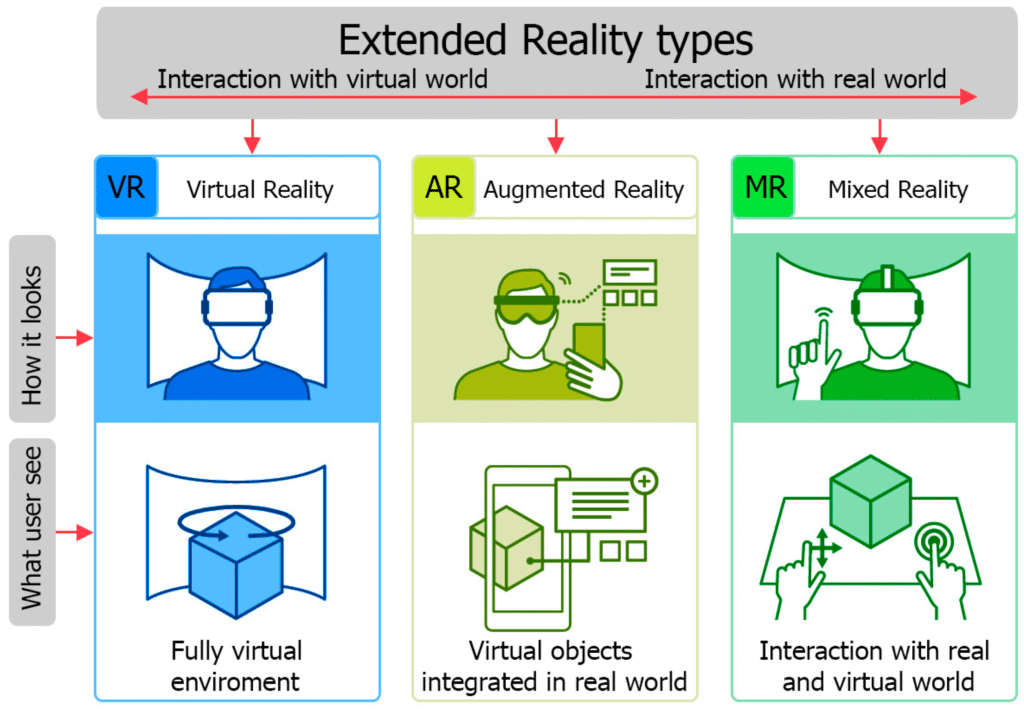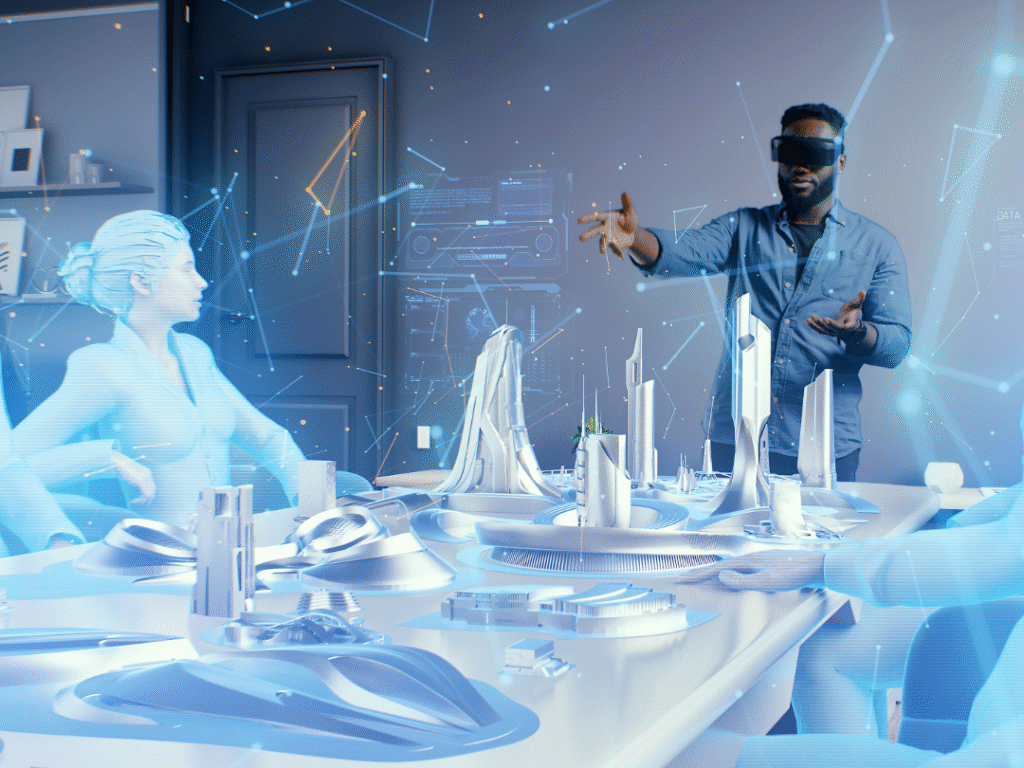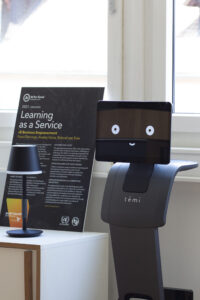Introduction
What was once dismissed as science fiction is now reality. We often hear the terms VR, AR, MR, and XR. Most people are at least familiar with virtual reality and may have tried it out at some point. But what is the difference between the various immersive technologies? This is not an unimportant question, because immersive technologies are becoming increasingly sophisticated, widespread, and relevant. Think of the metaverse and Apple’s Vision Pro.
These developments also mean that the technologies are increasingly being used in education. After all, they enable risk-free training in interactive learning environments and even collaborative work in mixed realities. In this blog post, we want to explain the differences and show how they can be applied in professional continuing education.
Overview of terms
Extended reality (XR) is a collective term for all immersive technologies. The term can therefore be used for all technologies, but it does not refer to a specific technology.

Virtual reality (VR) is probably the best known of the immersive technologies. In VR, you are immersed in completely digital worlds. You are completely isolated from the outside world and move around in a new 3D space. In VR, you can often interact with elements and/or people or AI. VR glasses such as the Meta Quest 3 are used to transport you into the virtual worlds.
Augmented reality (AR) enhances the real world with digital content such as text, graphics, images, and 3D objects. Unlike VR, the real world is not replaced by a computer-generated one, but rather individual elements are superimposed onto the real world. It is the most accessible form of immersive reality because, unlike VR, augmented reality uses not only AR and AR-compatible glasses, but also smartphones and tablets.
Mixed reality (MR) goes one step further than augmented reality. With MR, reality merges with virtual elements that can be interacted with in real time. This requires glasses that are equipped with either transparent lenses or cameras.
Differences at a glance
| Criterion | VR (Virtual Reality) | AR (augmented reality) | MR (Mixed Reality) | XR (extended reality) |
| Definition | Fully digital, immersive environment | Digital elements are integrated into the real world | Merging of the real and virtual worlds with real-time interaction | Umbrella term for all immersive technologies (VR, AR, MR) |
| Hardware | Standalone VR glasses or in conjunction with computers/game consoles | Smartphone, tablet, AR glasses, and AR-enabled VR glasses | MR headset (e.g., Hololens) or MR-enabled VR glasses | Combination of VR, AR, and MR devices |
| Experience for users | Complete immersion in a virtual world | Real world with digital overlays | Interaction with virtual objects in the real world | Depending on the technology: from partial to complete immersion |
| Examples of applications | Simulations, soft skills training, virtual tours | Training, learning support, visualization of complex elements | Collaboration, technical training, interactive learning projects | Future-oriented learning platforms |
| Advantages | High immersion, safe practice in simulations | Suitable for everyday use, mobile application | High interactivity, realistic | Flexible, future-proof, encompasses all technologies |
| Challenges | Costs, motion sickness, high hardware requirements | Limited display quality, potential for distraction | Expensive, technically demanding | Unclear standards, still in development |
| Areas of application in continuing education | Risk-free practice, e.g., in medicine or technology | Step-by-step instructions, practical learning | Team training, complex scenarios | Strategic use for holistic learning concepts |
Application examples in continuing education
Loft Dynamics
The Swiss company Loft Dynamics offers VR training solutions for flight and eVTOL simulators. Loft Dynamics is the only company that creates formally approved VR simulators for pilot training and practice. The introduction of VR simulators has led to higher-quality training while significantly reducing the cost of flight training.
Bodyswaps
The VR app Bodyswaps puts learners in realistic conversation situations. Specific situations such as employee appraisals and presentations can be practiced in a safe environment. The aim is to train soft skills such as empathetic communication, dealing with feedback, and conversation skills in difficult moments. Bodyswaps can be tested in our Innovation & Learning Lab. You can contact us here.
Ford
Ford uses mixed reality in the design process. Vehicles can be visualized in various ways, their use can be tested, and design aspects can be changed virtually. All of this with a focus on collaboration. The MR simulation can be used by several people at the same time, regardless of location. Ford also uses MR in quality testing. Powered by a HoloLens, employees are guided through the engine testing process. Employees learn on the job, making them more efficient and reducing errors.
Medtronic
Medtronic uses Microsoft’s HoloLens to train employees in medical technology. Processes and procedures are visually overlaid in training courses to make them more efficient and reduce the error rate. This has greatly simplified complex training sets.
Porsche
Automobile manufacturer Porsche trains technicians and service employees with VR. Employees learn virtually how complex components fit together. They can take them apart and put them back together again, getting to know them before working on real vehicles.
Boeing
At Boeing, AR glasses are used to superimpose work instructions onto real components while fitters are working. This leads to shorter assembly times and fewer errors.
Walmart
American retailer Walmart uses VR simulations to prepare employees for complex, stressful situations. In a safe, immersive environment , employees can learn how to deal with specific situations without disrupting the customer experience.
Opportunities & Challenges
Advantages of extended reality
- Higher motivation and engagement: Immersive learning environments increase attention and willingness to learn.
- Better understanding of complex content: Abstract processes (e.g., anatomy, technology, etc.) can be experienced visually and interactively.
- Repeatability without risk: Simulations enable safe practice.
- Long-term cost and resource savings: Once developed, scenarios can be used indefinitely and reduce material consumption.
- Location-independent learning: Learning is flexible and can basically be done anywhere, whether alone or in groups.
- Promotion of soft skills: Communication, teamwork, situational and intercultural skills can be trained in a realistic manner.
- Innovation advantage: Companies position themselves as modern and attractive to employees and customers.
Barriers to extended reality
- High acquisition costs: Hardware (headsets, possibly computers) and software/content development are expensive.
- Technical hurdles: Powerful hardware is required, possibly specialized personnel, software compatibility, maintenance.
- Motion sickness: Some users are sensitive to VR environments.
- Integration effort: Didactic concepts must be adapted and trainers must be trained.
- Data protection & security: Particularly relevant for cloud-based XR platforms.
- Lack of standards & interoperability: Different platforms and devices are not always compatible.
- Inequality of access: Not all educational institutions or employees have access to devices and software.
Future outlook

Although extended reality is already well developed, there is still a lot of innovation taking place. Headsets are becoming lighter, offering ever-better resolution and equipped with more and more mixed reality features. The integration of artificial intelligence is making XR learning environments even better and adapting them to the individual needs of learners. With the VR app VirtualSpeech, for example, conversations can be completely customized and individual feedback is provided on user performance, including suggestions for improvement.
Didactic developments are also taking place. Blended learning can be enhanced with XR aspects and learning processes can be personalized. There is also potential for the integration of gamification, which can be further expanded in XR applications. All of this is being driven by increasingly affordable hardware, greater availability on the mass market, and growing acceptance in companies. Extended reality is making continuing education more interactive, practical, and flexible. Companies can further differentiate themselves through innovative learning offerings and continue to build on lifelong learning.
What extended reality means for your continuing education
Whether virtual reality, augmented reality, or mixed reality—extended realities bring their own advantages and are revolutionizing continuing education. VR creates stress-free, realistic training environments, while AR offers support in everyday work with digital overlays. MR merges reality and virtuality, creating new interactive learning worlds with entirely new possibilities.
Companies who experiment with these technologies early on will emerge as winners sooner. They benefit not only from an innovative edge, but also from motivated employees and sustainable learning success.
If you would like to learn more about the potential of extended reality or simply want to try it out for yourself, please contact us. We would be happy to accompany you into new learning worlds.

